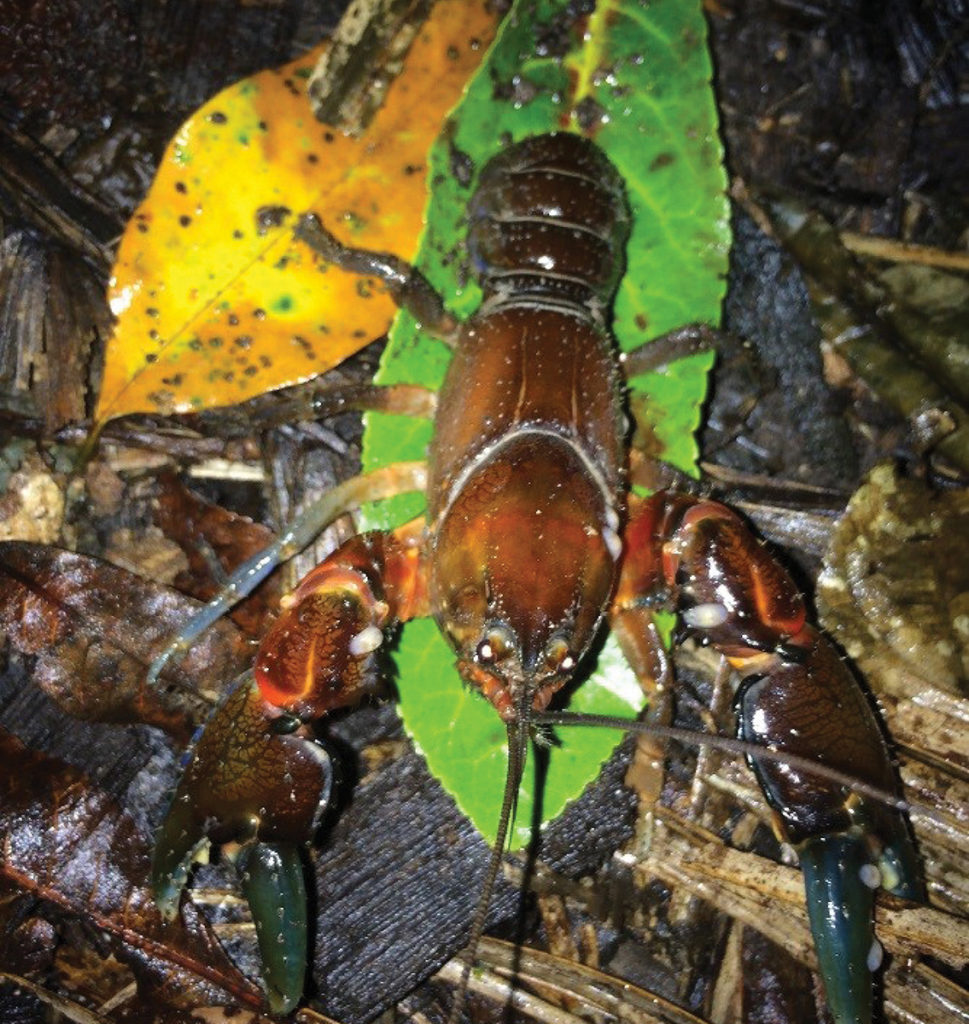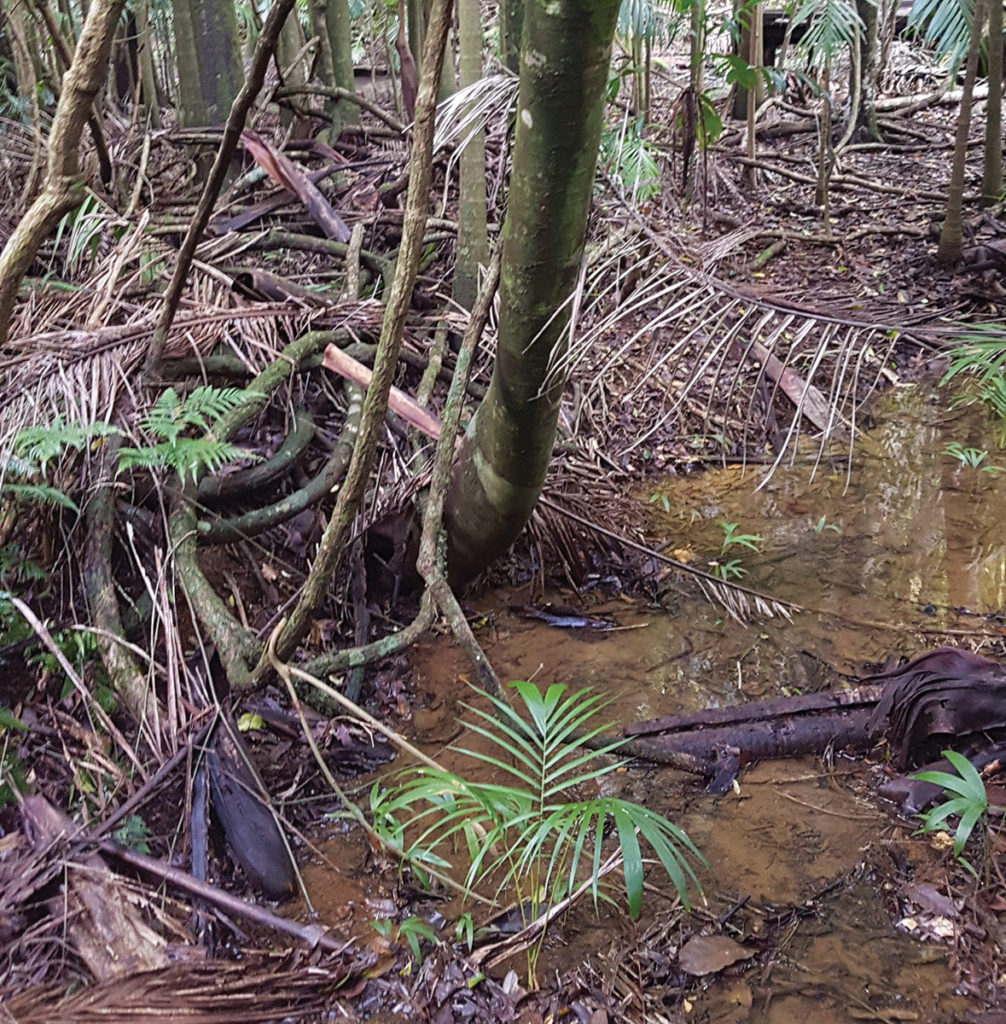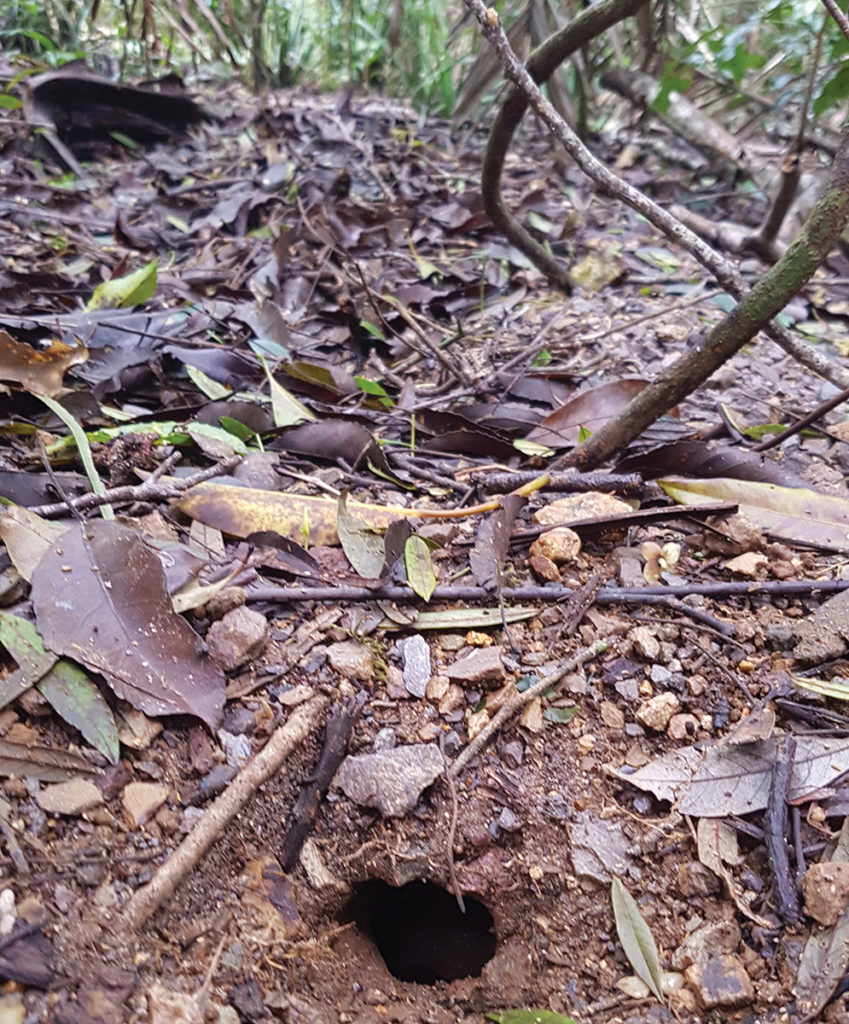One of the things I love is exploring the forest at my place after sunset. As you venture out in the dark to see what you can find, you realise there’s a whole world of life active at night that you just won’t see during the day. When I turn off the torch and just listen, I sometimes ponder how long some of the animals have lived here. One I’ve spent some time looking for is the Blackall Range Spiny Crayfish (Euastacus urospinosus) and it got me thinking about time itself.
The Blackall Range Spiny Crayfish is a small burrowing crayfish found on the Blackall and Conondale Ranges in the upper catchments of the Mary and Brisbane Rivers usually above 300m in elevation. They are found in streams and gullies dominated by Piccabeen Palms (Archontophoenix cunninghamiana) and they generally occur where crayfish of the genus Cheraxare absent. They are a truly endemic species found nowhere else in the world and the estimated area of their suitable habitat is only 76 km². All Euastacusspecies generally inhabit flowing, cool water streams usually in mountainous country separated by steep ridges or areas of low, flat land.

Other species of Euastacusin SEQ include:
Conondale Spiny Crayfish (E. hystricosus), which has an overlapping range with E. urospinosus.
Mt Glorious Spiny Crayfish (E. setosus) found in the D’Aguilar Range.
- jagarafound on the Great Dividing Range south-west of Ipswich.
Lamington Spiny Crayfish (E. sulcatus) found in the Gold Coast hinterland.
- maidaefound only in the upper reaches of Currumbin Creek.
Strong Spiny Crayfish (E. valentulus) found in southern SEQ and north-east NSW.
This genus is notable in that many species are only found on specific mountain ranges where they have been isolated for millions of years as climate change reduced their suitable habitat. They generally prefer cooler water so as you go further north they are found at higher altitudes. This requirement for cool water is thought to be a barrier to them moving between mountain ranges as they cannot survive in the surrounding lowlands. There are 53 species along the east coast of Australia with 33 found only in elevations above 250 metres. In Queensland there are 15 species of Euastacusand the only ones that occur near sea level are in the very far south-east near the NSW border.


So how does a small, burrowing crayfish lead to me pondering time itself? As I delved deeper into the research the latest DNA testing suggests that the current mix of Euastacusall shared a common ancestor in the Miocene over 5 million years ago. As our climate became drier the rainforests that had previously dominated were restricted to areas with a suitable cool, wet climate. Mountainous areas became key refugia for rainforests and their associated wildlife.
Euastacuscrayfish have become effectively isolated on their mountaintop ‘islands’ since the Miocene and have evolved into the different species we find today. DNA testing has found that the Blackall Range Spiny Crayfish has been a separate species from its closest relative the Mt Glorious Spiny Crayfish for 1.5-2 million years!
My family history is European, and you only have to go back ten thousand years to find my ancestors all living as small groups of hunter gatherers. Compared to spiny crayfish, ten thousand years is not a long time as they have lived here as a distinct species for 150-200 times longer! Even if you go back as far as the evolution of our species in Africa the spiny crayfish still have more than a million years on us. It puts a whole new twist on the question of how long do you have to live somewhere to be considered a ‘real’ local?
It’s when I’m in the forest at night that I realise if I’m really lucky I might get to share this land I call home with spiny crayfish for another 50-odd years. To think it’s been their home for millions of years is humbling to say the least. It’s also inspiring to think that by conserving my small patch I’m helping maintain a species that was here for millions of years before Homo sapiens evolved!
A special thanks to Mark Ponniah for his useful comments on evolutionary time lines.
References
Hurry C (2015) Comparative phylogeography and the population genetics of three endangered freshwater Euastacusspp. crayfish… PhD Thesis.Griffith University.
McCormack R & Van Der Werf P (2013) The distribution, ecology and conservation status of Euastacus urospinosus… Memoirs of the Queensland Museum – Nature56(2), 639-646.
Morgan G (1997) Freshwater crayfish of the genus Euastacusfrom New South Wales, with a key to all species of the genus. Records of the Australian Museum, Supplement23: 1-110.
Ponniah M & Hughes J (2004) The evolution of Queensland spiny mountain crayfish of the genus Euastacus… Evolution 58(5) 1073-1085.
Article by Michael Reif
Conservation Partnerships Officer, Sunshine Coast Council

Hi I live in nambour Queensland we had a burrowing species of crayfish living in our garden we where about 200 metres away from a small seasonal drain I also caught a couple from the drain and was able to breed them over many years they where quite prolific I would be interested in breeding a few species of spiny crayfish is there anywhere I can buy brood stock from cheers ken
Hi Ken.
It’s great that you have crayfish in your garden. The first step would be to try to identify what species it is to make sure it isn’t a pest species. The Qld Museum would be able to help you with ID from a photo using their online Ask an Expert service – https://www.qm.qld.gov.au/Find+out+about/Ask+an+Expert.
There is some good information too via:
https://www.dpi.nsw.gov.au/fishing/aquaculture/publications/species-freshwater/freshwater-crayfish-aquaculture-prospects
https://www.qm.qld.gov.au/Find+out+about/Animals+of+Queensland/Crustaceans/Common+freshwater+and+terrestrial+crustaceans
Hi Deborah, sorry if I’m a bit late on this but… If it’s still unknown I can confirm the burrowing crayfish in the upper Nambour region a Terrestrial species, Cherax Punctatus.
I have watched a colony of 6-7 adults and many of their young over a couple of years using 2 areas on my ex partners property located on a reasonably steep hill side at Image Flat, Nambour.
Which 1 of the 2 “living locations” they use is pending on the ground water levels…
In high rain fall they will cap off their lower burrows in the back yard from the inside of the burrow and move through under ground tunnels connecting up to 10m away directly up hill to their second location at the highest point of the property this is where will stay until the heavey rainfall stops.
A as ground water slowly drains away they follow moving back down the hill to lower burrows then breaking down the internal mud cap and using the excess mud to build up around the top of the burrows… which I believe from being able to observe them this close is to stop there burrow being flooded in unexpected weather events.
If you’d like to know anything else or have any questions at all I have left my email in the section below.
Cherax Punctatus, my ex partner lives up the top of image flat and has them in her front and back yard, nice find mate.
i have found these in the upper creeks in Bellthorpe state forest do not let them bite you i have seen a grown man scream when one grabbed his finger